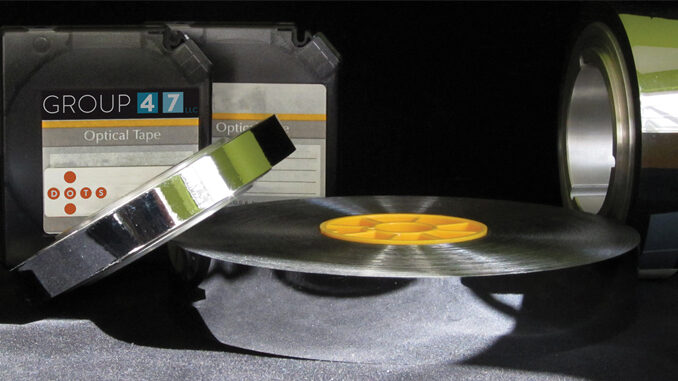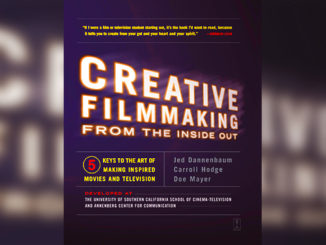
by John Lafferty, ACE
Archiving of media assets has been, and always will be, the red-headed step- child of the movie and TV business. It costs money now for an uncertain return at an unknown date––which doesn’t make for a very appealing budget line item. When production was film-based, negative trims and outtakes were routinely stored in vaults and available for either stock usage or restoration purposes for many decades.
Currently, when so much production is happening digitally with everything stored magnetically––either on tape or on drives––the inevitability of disintegration or corruption of data means that archives and libraries need to continually migrate their material to newer storage formats. Stored properly, the film was good for well over 100 years.
At Warner Bros., vice president of technical operations Steven Anastasi notes that the studio assumes a ten-year life for data stored on LTO (magnetic linear tape storage), a threshold that is rapidly approaching with high-definition material shot in the early 2000s. For many of these titles, Anastasi is deliberating whether to make film-outs or to migrate to LTO. In terms of the life of the data, a film-out is the equivalent of 10 migrations, and LTO tapes need to be checked at regular intervals to ensure data integrity and they are compatible only over two generations of the technology.
“Migration is broken. Migration practices do not scale to meet the digital preservation requirements.” – Storage Network Industry Association, 2007.
At Group 47 LLC, president Rob Hummel and chief technical officer Daniel Rosen saw a way out of the conundrum. When they were both at DreamWorks, Kodak had made a presentation to them about a new storage technology that was unique. It is now known as Digital Optical Tape System (DOTS), an entirely optical system. In DOTS, each bit is represented by an individual dot that is either on or off, unlike a DVD-style system where the device samples the signal generated by the laser at precise time intervals, which is then encoded digitally.
Rosen argues, “Because it’s optical, the media contain a representation of the data…not simply a method to modulate a signal, which can then be used to make a representation of the data.” Since Kodak was unable to commercialize the DOTS system to its financial benefit, Group 47 has recently acquired the DOTS patents and intellectual property, which it plans to bring to market through licensing agreements with manufacturers of hardware and media.
The heart of DOTS technology is an extremely stable storage medium––metal alloy treated using different processes by heat treating companies sputtered onto mylar tape––that undergoes a change in reflectivity when hit by a laser. The change is irreversible and doesn’t alter over time, making for a very reliable yet simple technology.
Approximately ten years ago, Kodak commissioned testing at Carnegie Mellon University, which the company halted after finding that over 100 years of simulated aging showed no degradation. The DOTS tape is resistant to magnetic fields, water and petrochemicals––surviving a weekend dunk in gasoline without any effects––a far cry from the temperature and humidity controls necessary for film and magnetic tape storage.

scale). Inset .5 to 1mm from the physical edge of the tape are two optical guide tracks. These tracks are used as fiducial marks for the image processing of the data, which is written between two “dead bands” (shown between the two pairs of red dotted lines). These dead bands (the red lines simply show the band boundaries and do not imply any dots having been made on the media) provide a separation zone between the actual data and the guide tracks.
As Rosen comments, DOTS’ longevity “changes data migration into a choice, not a requirement,” meaning that studios will migrate only when new formats call for it, not merely to avoid the disintegration of the data.
Once it’s fully implemented, Hummel and Rosen see DOTS as an end-to-end storage product for digital media. During production, as digital media are recorded to a hard drive, they can be simultaneously laid down to a DOTS recorder for immediate vaulting for both back-up, in case of drive failure, and long-term archiving.
Group 47’s goal is to fit the writer/reader into the same form factor as LTO for easy integration into existing infrastructure, and its licensing agreement with manufacturers would require what Hummel and Rosen call a “Rosetta Leader,” describing in human readable text how the data is encoded, as well as full details of how to build a reader, there- by ensuring technological longevity. The license would also mandate full back- ward compatibility to Generation Zero, achievable since readers capable of read- ing greater data densities should have no trouble reading lower density information.
Some studio archivists are less convinced that DOTS is a magic bullet for digital asset management, noting that they will need real-world information on the speed and accuracy of the technology’s read/write cycles, its robustness and cost. Of course, since DOTS is still only in development, if there are any critical weaknesses, they remain to be revealed. It should also be pointed out that LTO data densities have increased by a factor of 16 from LTO 1 to LTO 5. A feature that needed 48 tapes for storage now requires only two, and following Moore’s Law, data densities will increase faster than increases in resolution as acquisition moves from 2K to 4K and onward to 8K.
Group 47 is currently negotiating a licensing agreement with a well-known hardware and systems manufacturer to move toward manufacturing the DOTS system in the coming months. Whether or not DOTS becomes a commercial reality, the need for robust, reliable and accurate data storage will become increasingly important as enormous amounts of data are generated by digital production.





